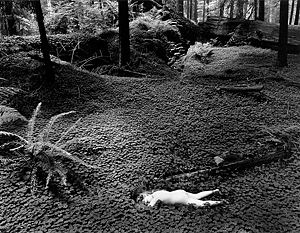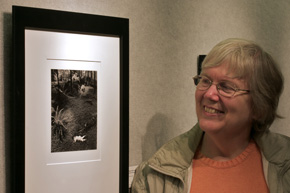CHILD IN FOREST, 1951
The photograph is of an ancient redwood forest. A lush growth of oxalis covers the forest floor. Huge fallen tree trunks are slowly nourishing the earth while slender new trees reach for the sky. Ferns spread their fronds outward in a quiet, graceful dance. Nearby a young girl lies, her smooth, fair skin luminous in the dappled sunlight.
 My father Wynn Bullock gave this image the simple title of Child in Forest, and it is probably the most widely recognized photograph he ever made. It was included in Edward Steichen's world-famous exhibition and book The Family of Man and the picture generated more controversy than any other image in the collection.
My father Wynn Bullock gave this image the simple title of Child in Forest, and it is probably the most widely recognized photograph he ever made. It was included in Edward Steichen's world-famous exhibition and book The Family of Man and the picture generated more controversy than any other image in the collection.
For years, as the exhibition traveled to museums and galleries around the globe, people would write, phone, and telegraph their questions to the Museum of Modern Art in New York. Mr. Steichen would forward them to Dad for a response. Is the child asleep or did something dreadful befall her? Does she belong where she is, did she come willingly, or was she brought to this place forcefully and then abandoned? Perhaps the figure is not a living thing at all, but rather a statue.
For Dad, the image was one of interesting contrasts – an ancient virginal forest and a young virginal child. These contrasts manifested the dynamic, cyclic character of natural forces. As he once described the making of it, he felt the light was just right, everything was spatially balanced and the relationships between events – the young child, the fresh forest covering, the prehistoric trees, the rotting logs – were all strong and exciting. Dad would encourage questioners to set aside any fears or preconceptions they might have. He would invite them to look at the photograph again. "Be with the child, feel her presence, see the leaves adorning her hair. Put yourself in the forest, watch the light, sense the life." He would go on to say, "There may be mystery here, but it isn't sinister. It's the mystery of difference and of oneness, of universal forces and relationships, of dimensions we can only begin to glimpse."
As the child in the photograph, I remember well the day it was taken, although I was only five or six years old at the time. Dad and Mom and I were traveling along Highway One in northern California so he could photograph. Around noon, we were looking for a place to stop and eat our picnic lunch. Having trouble finding a space large enough to park safely by the side of the road, we finally spied a very dusty turnout with a rickety picnic table and a trash can overflowing with litter. We stopped, ate our lunch, and then Dad wandered off into the woods. A few minutes later he returned, excited by what he had just seen.
He got his camera equipment out of the trunk of the car, and Mom and I followed him back into the woods. Walking only a few hundred feet from the dreary picnic area, we found ourselves in the middle of a primeval forest.
Dad asked me to take my clothes off and lie down in the bed of oxalis. It was not an unusual request and I already understood that when he was photographing a model, an unclothed body meant getting closer to nature. It was a good and "natural" thing to do.
When I first lay down, I was very unhappy to discover dry, prickly redwood needles underneath the lovely, soft green leaves. I'm afraid I wasn't very cooperative until Mom arranged a blanket under my body. Then I was able to relax and I can still vividly remember the smell of the damp, rich earth; the warmth of the light playing on my body; the hushed yet thrumming energy of the forest. Dad took his pictures, Mom helped me get dressed, and we walked slowly and silently back to the car.
 A few years later, when this photograph and another of Dad's were selected to be part of The Family of Man show at the New York Museum of Modern Art, our local newspaper displayed a copy of it on the front page, along with a feature article. I was in the second or third grade at the time and I clipped the picture and article to share with my class during "Show and Tell." When my turn came to stand in front of the class, I believed that I had been part of something beautiful and special. I was very proud of my father and excited about what was happening.
A few years later, when this photograph and another of Dad's were selected to be part of The Family of Man show at the New York Museum of Modern Art, our local newspaper displayed a copy of it on the front page, along with a feature article. I was in the second or third grade at the time and I clipped the picture and article to share with my class during "Show and Tell." When my turn came to stand in front of the class, I believed that I had been part of something beautiful and special. I was very proud of my father and excited about what was happening.
All those wonderful feelings, however, vanished the moment I held up the clipping. What I saw was shock and disbelief, what I heard was giggling, what confronted me were waves of embarrassment and discomfort. In that moment, I felt "naked" for the first time in my life and I discovered just how different my life and my family were from those of most of my friends and classmates.
My teacher was not very understanding or comforting, and the day wore on interminably before I was able to go home. Once there, I found the love and wisdom I needed to feel right and whole again.
Whenever opportunities arose during family outings, I continued working with Dad until he moved on in his photography and began to focus on other kinds of imagery. That shift happened around 1958. By then, I was about thirteen and I knew what a special gift I had been given as a valued participant in the image-making process.
~ Essay by Barbara Bullock-Wilson © 2015. All rights reserved.

